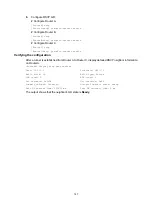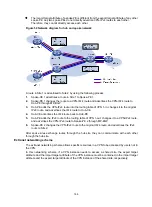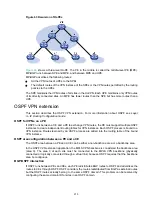
196
•
When the Type field is 2, the Administrator subfield occupies four bytes, the Assigned number
subfield occupies two bytes, and the RD format is
32-bit AS number
:
16-bit user-defined number
,
where the minimum value of the AS number is 65536. For example, 65536:1.
To guarantee global uniqueness for a VPN-IPv4 address, do not set the Administrator subfield to any
private AS number or private IP address.
Route target attribute
MPLS L3VPN uses route target community attributes to control the advertisement of VPN routing
information. A VPN instance on a PE supports the following types of route target attributes:
•
Export target attribute
—A PE sets the export target attribute for VPN-IPv4 routes learned
from directly connected sites before advertising them to other PEs.
•
Import target attribute
—A PE checks the export target attribute of VPN-IPv4 routes received
from other PEs. If the export target attribute matches the import target attribute of a VPN
instance, the PE adds the routes to the routing table of the VPN instance.
Route target attributes define which sites can receive VPN-IPv4 routes, and from which sites a PE
can receive routes.
Like RDs, route target attributes can be one of the following formats:
•
16-bit AS number
:
32-bit user-defined number
. For example, 100:1.
•
32-bit IPv4 address:16-bit user-defined number
. For example, 172.1.1.1:1.
•
32-bit AS number
:
16-bit user-defined number
, where the minimum value of the AS number is
65536. For example, 65536:1.
MP-BGP
MP-BGP supports multiple address families, including IPv4 multicast, IPv6 unicast, IPv6 multicast,
and VPN-IPv4 address families.
In MPLS L3VPN, MP-BGP advertises VPN-IPv4 routes for VPN sites between PEs.
MPLS L3VPN route advertisement
In a basic MPLS L3VPN, CEs and PEs are responsible for advertising VPN routing information. P
routers maintain only the routes within the backbone. A PE maintains only routing information for
directly connected VPNs, rather than for all VPNs.
VPN routing information is advertised from the local CE to the remote CE by using the following
process:
1.
From the local CE to the ingress PE:
The CE advertises standard IPv4 routing information to the ingress PE over a static route, RIP
route, OSPF route, IS-IS route, EBGP route, or IBGP route.
2.
From the ingress PE to the egress PE:
The ingress PE performs the following operations:
a.
Adds RDs and route target attributes to these standard IPv4 routes to create VPN-IPv4
routes.
b.
Saves the VPN-IPv4 routes to the routing table of the VPN instance created for the CE.
c.
Advertises the VPN-IPv4 routes to the egress PE through MP-BGP.
3.
From the egress PE to the remote CE:
After receiving the VPN-IPv4 routes, the egress PE performs the following operations:
a.
Compares the routes' export target attributes with the local import target attributes.
b.
Adds the routes to the routing table of the VPN instance if the export and local import target
attributes match each other.
c.
Restores the VPN-IPv4 routes to the original IPv4 routes.
















































